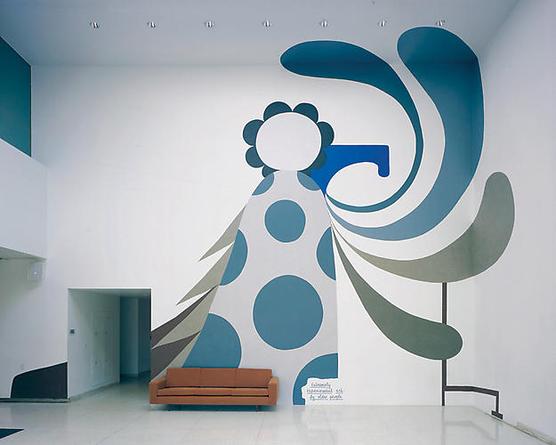
Lily van der Stokker (b. 1954, The Netherlands)
Extremely Experimental Art by Older People, 2000
While pondering about concepts, categories and frames, sooner or later I start testing the frame or border of a particular artwork as well. Is it really all that obvious where it ends, what’s inside and what’s outside? Perhaps, in most cases it is reasonably easy to at least assess what in the work has been done by the artist – e.g. “all that smearing of the paint onto the canvas within that frame”, even if there must have been more efforts that have gone into shaping of that particular experience – from someone training the gallery’s spotlight in that particular manner to the audience’s movements, facial expressions and gestures in response to the work while making sense of it. But then again, is it always certain that everything within the frame was done by the artist – did they actually stretch the canvas, did they do the framing? Just as it may have been the artist herself who hanged the painting in the gallery, trained the spotlight onto it and then made a little dance number in front of it.
I quite like this porosity of art, always leaking into “reality” just as reality keeps bleeding into art. I don’t know if I find this interesting just as reflexive resistance to all the theorisations that try to posit the art and the reality apart, or if there is more to it. I’d guess, it would be about arbitrariness of our concepts and their demarcations – what they reveal, what they obscure and how that can be more or less meaningful, more or less beneficial, more or less harmful in different contexts and from different perspectives.
That is what I like about van der Stokker – her paintings bleeding out across the wall, occasionally hitting the floor or the ceiling, taking space in the form of a piece of furniture, blurring a lot of boundaries, creating uncertainty as to what to include in the act of “appreciation of art” and on what grounds… Her title for this particular piece is also brilliant, tickling some conceptual boundaries as well, e.g. in terms of experimentation in relation to age…
I am quite keen to test this kind of boundaries myself. I’ve experimented with performances that had no marking for their start or finish. I’ve initiated casual conversations that I later designated as artworks. My “Find The Art Piece” was the most focused one in this regard – asking the audience to discuss the piece without providing any other pointer as to what the piece consist of other than it “being in this room”.